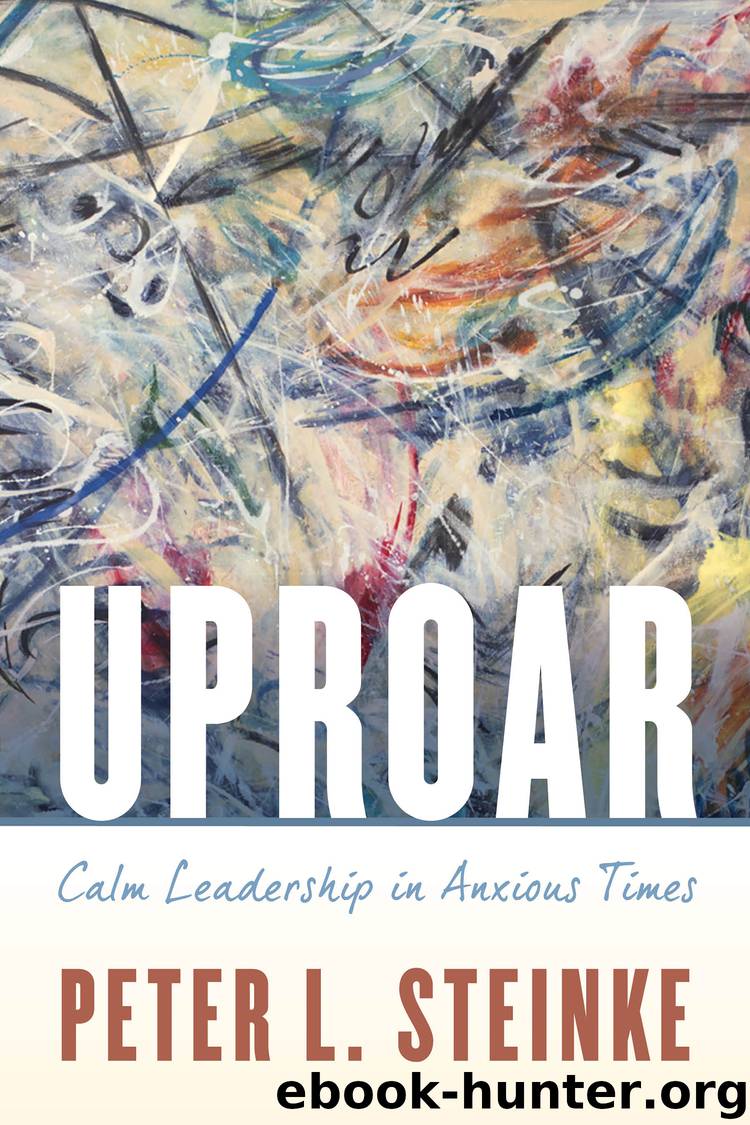Uproar by Peter L. Steinke

Author:Peter L. Steinke [Steinke, Peter L.]
Language: eng
Format: epub
Publisher: Rowman & Littlefield Publishers
Published: 2018-11-07T16:00:00+00:00
Borders, Lines, and Edges
I find the belligerence with which creationists and evolutionary theorists debate the biblical creation story a waste of energy. I don’t think the Hebrew writer of Genesis, or the readers, were drawn into the questions of creation’s “how” and “how long.” The Hebrews were more interested, it seems to me, in relationships that eventually culminated in the Covenant. The creation text itself is contained in the Old Covenant, and its great moral code, the Ten Commandments, addresses the connection between the divine and the human, and relationships between one another. In fact, the ensuing biblical stories center around the tension between two brothers; family squabbles; welcoming the stranger; the Jewish idea of distributive justice; being sensitive to the plight of the marginal, especially orphans and widows who had no social standing; multiple stories about the violation of personal boundaries; and seeking shalom (the full flourishing of life) for all. Simply put, relationships count. That’s the central narrative.
The key to it all, surprisingly, is the text of Genesis 1:2: “The earth was a formless void and darkness covered the face of the earth.” It was an undifferentiated mess (or, to use Bowen’s phrase, an “undifferentiated mass”), a maelstrom of universal proportion. The great fear was a relapse to the primal condition, a return to boundaryless chaos. The separation of the day from the night, the earth from the sky, and the land from the sea signaled the need for boundaries to ensure a relatively stable form of life.
Also, Adam was assigned to language arts class. Name it all! There had to be definitions. Literary critic Roland Barthes says the “founding function of differences . . . is the basis of language.” Words provide distinctions, specificity. Without borders, there would be a gross “stuck-togetherness,” nothing to hit against, no moving against the tide, no self/other dimension, no ordering function, no integrity, and a paralyzing sameness. Always, the latent threat of “a formless void” would linger.
Boundaries offer identification, protection, and connection. Writing about human nature, Theodore Schwenk says, “Boundaries are the birthplace of living things.” Membranes encapsulate. “When the earth came alive,” Lewis Thomas claims, “it began constructing its own membrane, for the purpose of editing out the sun.” It is the membrane around a cell in biology, the skin of a raindrop, and the image of a separate self that provide identity and differentiation. Clouds have no membrane and, unstable, drift into other forms or dissipate into fog. Clouds develop types (cumulus, cirrus, and stratus) but not identifiable forms.
Download
This site does not store any files on its server. We only index and link to content provided by other sites. Please contact the content providers to delete copyright contents if any and email us, we'll remove relevant links or contents immediately.
| Ethics | Etiquette |
| Fashion & Image | Health & Stress |
| Motivation & Self-Improvement | Work Life Balance |
| Workplace Culture |
Tools of Titans by Timothy Ferriss(8212)
Change Your Questions, Change Your Life by Marilee Adams(7633)
Deep Work by Cal Newport(6873)
Man-made Catastrophes and Risk Information Concealment by Dmitry Chernov & Didier Sornette(5921)
Playing to Win_ How Strategy Really Works by A.G. Lafley & Roger L. Martin(5911)
Digital Minimalism by Cal Newport;(5661)
Big Magic: Creative Living Beyond Fear by Elizabeth Gilbert(5610)
The Slight Edge by Jeff Olson(5346)
Ego Is the Enemy by Ryan Holiday(5292)
The Motivation Myth by Jeff Haden(5154)
Stone's Rules by Roger Stone(5026)
The Laws of Human Nature by Robert Greene(4996)
Tuesdays with Morrie by Mitch Albom(4683)
Eat That Frog! by Brian Tracy(4430)
Rising Strong by Brene Brown(4377)
Skin in the Game by Nassim Nicholas Taleb(4161)
Bullshit Jobs by David Graeber(4093)
The Money Culture by Michael Lewis(4073)
Skin in the Game: Hidden Asymmetries in Daily Life by Nassim Nicholas Taleb(3929)
